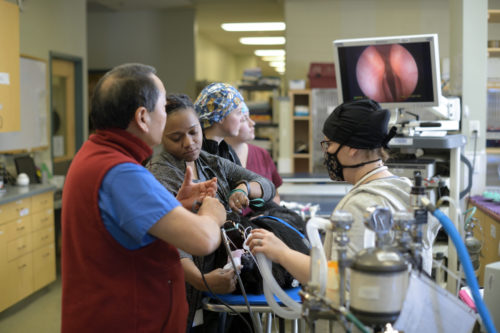Bilateral Vocal Fold Excision (Mucosoplasty) & Bilateral Arytenoidpexy (BVEAP) Approach to Laryngeal Paralysis in Dogs

Learn how your patient can benefit from the BVEAP technique over the “tie back”.

Dr. Ken Sadanaga is recognized for pioneering a new surgical technique to treat laryngeal paralysis in dogs that addresses both the intraluminal and extraluminal contribution of laryngeal paralysis, which the traditional “tie back” method does not.
With the tie back method, one side of the lumen is opened permanently to allow for increased airflow. This technique works well to open the airway and improve breathing but increases the risk of aspiration pneumonia for the remainder of the dog’s life.
With the BVEAP technique, the compromised vocal cords are removed to open the lower intraluminal area of the larynx and the arytenoid cartilages are pexied to thyroid cartilage—thus, addressing the extraluminal contribution to laryngeal paralysis. This artytenoidpexy opens the larynx in a more conservative and symmetrical manner, maintaining a better interface between the glottis and epiglottis during the act of swallowing and therefore significantly reducing the potential for aspiration pneumonia.
Advantages of BVEAP Over “Tie Back”
- Dogs can swim post-op, which is not recommended after tie back
- Creates a more functional airway
- Significantly less prone to aspiration pneumonia
To consult with Dr. Sadanaga regarding this innovative technique, contact him at 610-647-2950.






 Email
Email
